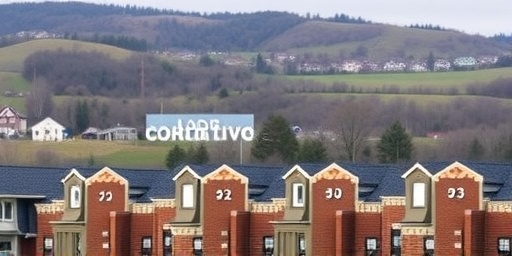In the rust-belt heart of Pennsylvania’s Northampton County, a once-stalwart battleground for Donald Trump, whispers of economic despair are turning into roars of frustration. Voters here, many of whom backed the former president in 2016 and 2020, are grappling with ballooning grocery bills and healthcare expenses that are eroding their loyalty faster than a Lehigh Valley storm. As the 2026 midterms loom, this Affordability crisis is not just squeezing family budgets—it’s reshaping the political landscape, giving Democrats a rare opening to flip key seats in the Keystone State.
- Northampton Families Battle Surging Grocery Prices Amid Inflation Surge
- Healthcare Costs Skyrocket, Straining Even Loyal Trump Voters
- Democrats Capitalize on Economic Grievances to Challenge GOP Strongholds
- Polls Reveal Cracks in Trump’s Pennsylvania Support Base
- Outlook for 2026: Midterms Hinge on Economic Relief Measures
Northampton County, with its mix of steel-town grit and suburban sprawl, delivered Trump a narrow victory margin in past elections. But recent surveys and on-the-ground reporting reveal a stark shift: 62% of residents now cite rising costs as their top concern, surpassing even immigration and crime. This discontent is bleeding into the political arena, where Trump’s shadow still looms large, but his grip on these voters feels increasingly tenuous.
Northampton Families Battle Surging Grocery Prices Amid Inflation Surge
The local Acme supermarket in Bethlehem, Pennsylvania, used to be a symbol of everyday Affordability—a place where working-class families could stock up without a second thought. Today, it’s a battleground of its own. Sarah Jenkins, a 42-year-old nurse and mother of three who voted for Trump in 2020, scans the aisles with a furrowed brow. “Milk was $2.50 a gallon last year; now it’s pushing $4. And don’t get me started on eggs—up 50% since the pandemic,” she says, her cart half-full but her wallet feeling empty.
Northampton County’s grocery inflation mirrors national trends but hits harder in this blue-collar enclave. According to the U.S. Bureau of Labor Statistics, food-at-home prices in the Northeast rose 5.2% year-over-year in the latest report, outpacing the national average of 4.1%. Locally, the Lehigh Valley Food Bank reports a 35% spike in demand since 2022, with pantries in Easton and Bethlehem overwhelmed by requests from families earning under $60,000 annually—the median income here.
Experts attribute this to a perfect storm: supply chain disruptions from global conflicts, avian flu outbreaks driving up poultry costs, and lingering effects of federal policies that some blame on both parties. “In Pennsylvania, where manufacturing jobs haven’t fully rebounded post-COVID, these increases aren’t abstract—they’re dinner or debt,” notes Dr. Elena Ramirez, an economist at Lehigh University. Her research shows that 40% of Northampton households are now spending over 15% of their income on food, a threshold the USDA flags as food insecurity.
For Trump supporters like Jenkins, the frustration is personal. “I believed in draining the swamp and bringing back jobs,” she admits. “But when my kids ask why we can’t afford their favorite cereal anymore, it’s hard to stay loyal.” This sentiment echoes across diners and union halls, where conversations once dominated by trade tariffs now revolve around the Federal Reserve’s interest rate hikes exacerbating everyday Affordability woes.
Healthcare Costs Skyrocket, Straining Even Loyal Trump Voters
Beyond the grocery aisle, healthcare expenses are delivering another blow to Northampton’s residents. At the St. Luke’s University Health Network in Allentown, emergency rooms are busier than ever, not just with illnesses but with delayed treatments due to cost barriers. Mark Thompson, a 55-year-old machinist from Nazareth who proudly displays a Trump 2020 yard sign, recently skipped a routine check-up. “My premiums jumped 18% this year through my union plan,” he explains. “Deductibles are so high now that I wait until it’s an emergency. It’s terrifying.”
Pennsylvania’s healthcare affordability crisis is acute in Northampton County, where the uninsured rate hovers at 8.5%, higher than the state average of 6.2%, per Kaiser Family Foundation data. Prescription drug prices have surged 12% statewide since 2021, with insulin and blood pressure meds leading the charge. The county’s aging population—median age of 43—amplifies the pain, as Medicare gaps leave many retirees vulnerable.
Democrats point to the Affordable Care Act’s expansions under Biden as a partial buffer, but Republicans, including Trump allies, argue it’s bloated bureaucracy driving up costs. Yet, even in conservative circles, the narrative is shifting. A recent Quinnipiac University poll in Pennsylvania found that 55% of Trump 2020 voters now disapprove of how the GOP has handled healthcare affordability, up from 38% in 2022. “This isn’t partisanship; it’s survival,” says Thompson. “If Trump wants our votes in 2026, he needs to address this head-on.”
Local advocacy groups like the Pennsylvania Health Access Network are mobilizing, hosting town halls where stories like Thompson’s dominate. One such event in Palmer Township drew over 200 attendees, many waving faded MAGA hats while demanding action on drug price caps—a policy Trump promised but has seen little progress on federally.
Democrats Capitalize on Economic Grievances to Challenge GOP Strongholds
As affordability concerns mount, Democrats are sharpening their midterm playbook, zeroing in on Pennsylvania’s competitive districts like the 7th, which includes Northampton County. The party, still smarting from 2022 losses, sees the affordability crisis as a wedge issue to peel away working-class voters from Trump. “Pennsylvania isn’t just a battleground; it’s the battleground,” declares State Sen. Katie Muth, a Democrat from Montgomery County eyeing a congressional run. “Voters here are tired of rhetoric—they want relief on groceries and doctor bills.”
The strategy is multifaceted: grassroots campaigns emphasizing Biden’s infrastructure investments, which have funneled $2.5 billion into Pennsylvania’s roads and bridges, promising job growth. Yet, critics argue these haven’t trickled down fast enough to counter inflation. Democrats are also pushing state-level bills, like expanded child tax credits, projected to save average families $500 annually. In Northampton, volunteer canvassers from the state Democratic Party are knocking on doors, armed with data showing how Republican-led Congress blocked insulin price caps.
Polling backs their optimism. A Franklin & Marshall College survey from last month indicates Democrats leading Republicans by 7 points on handling the economy in Pennsylvania, a reversal from 2022. Among independents in battleground counties like Northampton, affordability tops the list at 68%, with 52% leaning toward Democratic candidates who promise targeted relief. “This is our moment,” Muth adds. “Trump’s base is fraying, and we’re ready to knit it into our coalition.”
But it’s not without risks. GOP operatives warn that overplaying economic populism could alienate moderates if inflation eases. Still, in coffee shops from Slatington to Wind Gap, the buzz is clear: affordability is the midterm’s make-or-break issue, and Democrats are positioning themselves as the antidote.
Polls Reveal Cracks in Trump’s Pennsylvania Support Base
Delving deeper into the data, recent polls paint a precarious picture for Trump in Pennsylvania. The venerable Morning Consult tracker shows his favorability dipping to 45% statewide, with Northampton County voters at just 48% approval—a five-point drop since January. When affordability is isolated as a topic, support craters: only 39% of 2020 Trump voters say they’d back a GOP candidate echoing his economic vision without major reforms.
These shifts are driven by demographics. Younger voters under 35 in the county, hit hardest by student debt and entry-level wage stagnation, are swinging left; 60% now identify as independents open to Democrats. Meanwhile, women, who make up 51% of the electorate, cite healthcare and grocery costs as reasons for disillusionment. A focus group conducted by the Republican National Committee in Allentown last week revealed raw feedback: “Trump talked tough on China and trade, but my Walmart bill is killing me,” one participant vented.
National implications ripple outward. Pennsylvania’s 19 electoral votes were pivotal in 2020, and its congressional delegation—split 10-9 Democrat—could tip the House balance in 2026. Analysts at the Cook Political Report have upgraded three Pennsylvania districts to “lean Democratic,” citing affordability as the catalyst. Trump himself, campaigning in nearby Bucks County last month, acknowledged the pressure: “We’re fighting inflation like never before,” he said, though specifics on Pennsylvania were sparse.
Local GOP leaders are scrambling. Northampton County Republican Chair Tom Carroll hosted a strategy session, urging candidates to highlight Trump’s past tax cuts. “Affordability is real, but we can’t let Democrats own the narrative,” Carroll insists. Yet, with midterms 18 months away, the party’s challenge is clear: rebuild trust on the pocketbook issues that once defined their appeal.
Outlook for 2026: Midterms Hinge on Economic Relief Measures
Looking ahead, the affordability crisis in Pennsylvania could redefine the 2026 midterms, forcing both parties to pivot toward tangible solutions. For Trump and Republicans, reclaiming Northampton’s loyalty means delivering on promises like energy independence to lower utility bills—already up 22% in the county—and pushing for federal grocery tax holidays. Initiatives like the proposed “America First Affordability Act,” floated by GOP senators, aim to cap food price increases, but passage remains uncertain amid divided government.
Democrats, buoyed by early momentum, are doubling down on state and federal fronts. Gov. Josh Shapiro’s administration has allocated $100 million for healthcare subsidies in underserved areas, with Northampton slated for $15 million. Nationally, the party eyes expanding the Child Tax Credit, which could inject $1,000 per family in Pennsylvania, directly addressing voter pain points.
Experts predict a volatile cycle. “If inflation cools below 3% by summer 2025, Trump rebounds; if not, Democrats could net three to five seats here,” forecasts political scientist Dr. Marcus Hayes of Penn State. Community leaders in Northampton are organizing bipartisan forums, hoping to bridge divides. For residents like Jenkins and Thompson, the stakes are immediate: a chance for relief before the next election cycle amplifies their struggles.
As campaign seasons heat up, Pennsylvania’s affordability woes will test loyalties, strategies, and the very fabric of its political identity. In this battleground, the true winners may be those who listen hardest to the voices at the checkout line.









